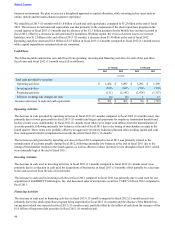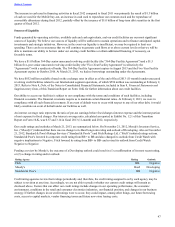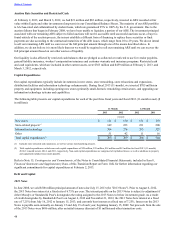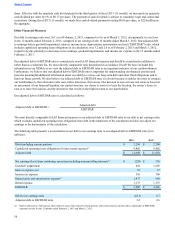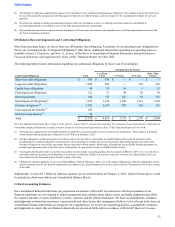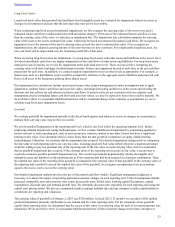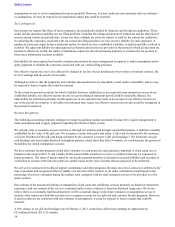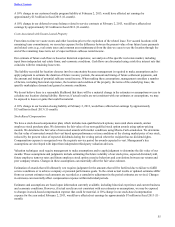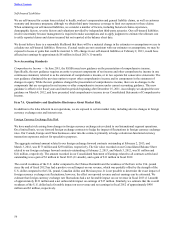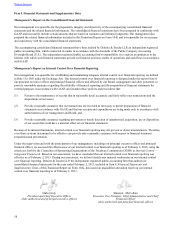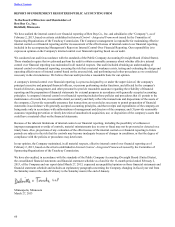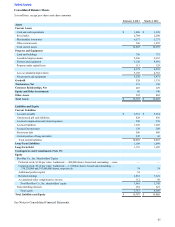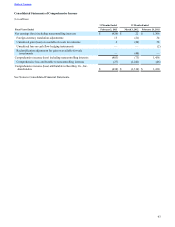Best Buy 2013 Annual Report Download - page 55
Download and view the complete annual report
Please find page 55 of the 2013 Best Buy annual report below. You can navigate through the pages in the report by either clicking on the pages listed below, or by using the keyword search tool below to find specific information within the annual report.
55
A 10% change in our customer loyalty program liability at February 2, 2013, would have affected net earnings by
approximately $13 million in fiscal 2013 (11-month).
A 10% change in our deferred revenue balance related to service contracts at February 2, 2013, would have affected net
earnings by approximately $13 million in fiscal 2013 (11-month).
Costs Associated with Vacant Leased Property
From time-to-time we vacate stores and other locations prior to the expiration of the related lease. For vacated locations with
remaining lease commitments, we record an expense for the difference between the present value of our future lease payments
and related costs (e.g., real estate taxes and common area maintenance) from the date we cease to use the location through the
end of the remaining lease term, net of expected future sublease rental income.
Our estimate of future cash flows is based on historical experience; our analysis of the specific real estate market, including
input from independent real estate firms; and economic conditions. Cash flows are discounted using a risk-free interest rate that
coincides with the remaining lease term.
The liability recorded for location closures involves uncertainty because management is required to make assumptions and to
apply judgment to estimate the duration of future vacancy periods, the amount and timing of future settlement payments, and
the amount and timing of potential sublease rental income. When making these assumptions, management considers a number
of factors, including historical experience, the location and condition of the property, the terms of the underlying lease, the
specific marketplace demand and general economic conditions.
We do not believe there is a reasonable likelihood that there will be a material change in the estimates or assumptions we use to
calculate our location closing liability. However, if actual results are not consistent with our estimates or assumptions, we may
be exposed to losses or gains that could be material.
A 10% change in our location closing liability at February 2, 2013, would have affected net earnings by approximately
$15 million in fiscal 2013 (11-month).
Stock-Based Compensation
We have a stock-based compensation plan, which includes non-qualified stock options, nonvested share awards, and an
employee stock purchase plan. We determine the fair value of our non-qualified stock option awards using option-pricing
models. We determine the fair value of nonvested awards with market conditions using Monte-Carlo simulation. We determine
the fair value of nonvested awards that vest based upon performance or time conditions at the closing market price of our stock,
reduced by the present value of expected dividends during the vesting period where the recipient has no dividend rights.
Compensation expense is recognized over the requisite service period for awards expected to vest. Management's key
assumptions are developed with input from independent third-party valuation advisors.
Valuation techniques used require management to make assumptions and to apply judgment to determine the fair value of our
awards. These assumptions and judgments include estimating the future volatility of our stock price, expected dividend yield,
future employee turnover rates and future employee stock option exercise behaviors and correlations between our returns and
peer company returns. Changes in these assumptions can materially affect the fair value estimate.
Estimation of awards that will ultimately vest requires judgment for the amounts that will be forfeited due to failure to fulfill
service conditions or to achieve company or personal performance goals. To the extent actual results or updated estimates differ
from our current estimates such amounts are recorded as a cumulative adjustment in the period estimates are revised. Changes
in estimates can materially affect compensation expense within individual periods.
Estimates and assumptions are based upon information currently available, including historical experience and current business
and economic conditions. However, if actual results are not consistent with our estimates or assumptions, we may be exposed
to changes in stock-based compensation expense that could be material. A 10% change in our stock-based compensation
expense for the year ended February 2, 2013, would have affected net earnings by approximately $7 million in fiscal 2013 (11-
month).
Table of Contents



